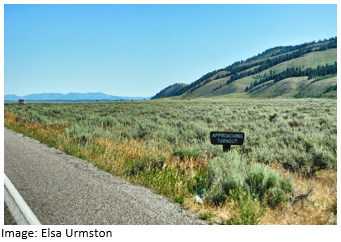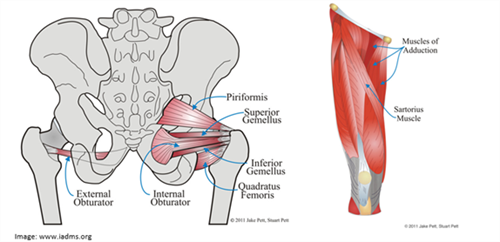Approaching turnout with young dancers: Muscles that rotate the leg
Author: Elsa Urmston on behalf of the IADMS Education Committee
 All too often we see our young dancers forcing their turnout in an attempt to achieve the illusive 180 degree line of the feet whilst often compromising the neutral line of the spine and pelvis and putting the knees, ankles and feet at high risk of injury.
All too often we see our young dancers forcing their turnout in an attempt to achieve the illusive 180 degree line of the feet whilst often compromising the neutral line of the spine and pelvis and putting the knees, ankles and feet at high risk of injury.
The last blog post by the IADMS Education Committee focussed on the anatomy of the hip joint; this time we take a look at the muscles which govern turn out and the lateral rotation of the hip. Knowing which muscles do what can help young dancers especially work more efficiently; talking about the location and function of those muscles and showing images of them can really inspire children and young people to maximise the rotation of the hip whilst working safely and effectively. And reminding them that there are no turnout muscles in the feet is a light-hearted reminder of how turnout should work! There are some great applications available which can help our dancers to clearly understand the anatomy and musculature of turnout, and are well worth bringing into the classroom, such as 3D for Medical Muscle System and VisibleBody.
Whilst the most obvious muscles of the hips are located in the buttocks, the muscles that are vital for turnout are the six deep lateral rotators, buried under the gluteal muscles and deep within the pelvic girdle. Identifying and recruiting these muscles can be tough and we often see an over-recruitment of the gluteus maximus in an effort to rotate the legs, both when standing and gesturing the leg in a non-weight-bearing position. The deep lateral rotators aid the efficient rotation of the leg, running laterally across the back of the hip joint capsule. They all attach on or adjacent to the greater trochanter of the femur and achieve rotation by pulling the greater trochanter backwards, towards the back of the pelvis. As well as the diagrams below, take a look at this great animation which demonstrates the location and function of these muscles in hip rotation.

Other muscles contribute to the rotation of the leg too. The sartorius is thought to help turn out the leg when the hip is flexed or abducted such as in retiré or attitude devant. And the inside thigh muscles (adductors) may also contribute to the rotation of the legs when they are extended and already turned out by the deep lateral rotators. In class I tend to talk about the adductor muscles lengthening to aid the rotation of the leg, especially when the leg is extended to second; this tends to bring about less tension and ensures that the deep lateral rotators remain the primary rotators of the legs, both when weightbearing and gesturing the leg.
It is important to remember that external hip rotation and turnout are not really the same thing. Anatomically, 60% of turnout is achieved by the outward rotation of the hip. The rest tends to come from the ankle, followed by the knee joint and tibia itself.
The problem here of course is when those deep rotators are not recruited first. This, coupled with anatomical factors which hinder the rotation of the leg, can mean that the dancer screws the leg from the foot upwards in a bid to achieve that 180 degree line of the feet I mentioned earlier. This places huge torsion on the big toe joint, ankles and knees – a recipe for greater likelihood of injury. The knock on effect of this screwing action also often means that the alignment of the pelvis and spine are compromised. So, the use of core support and an awareness of pelvic alignment are also crucial if turnout is to be fully functional in dynamic dancing. The recruitment of the deep rotators and the stability of controlled foot placement on the floor are the key elements for the safe recruitment of turnout whilst dancing.
There is a range of specific exercises for conditioning the turnout muscles, and for helping dancers to recruit the primary and supporting muscles involved in rotating the leg and maintaining efficient alignment of the spine and pelvis. Take a look at the IADMS Resource Papers for lots more information and ideas to take into class:
- Turnout for Dancers: Hip Anatomy and Factors Affecting Turnout
- Turnout for Dancers: Supplemental Training
Further Reading:
Grossman G, Krasnow D and Welsh TM. Effective use of turnout: biomechanical, neuromuscular, and behavioral considerations. Journal of Dance Education 2005;5(1):15-27.
Elsa Urmston, MSc, PGCAP, AFHEA, is the DanceEast Centre for Advanced Training Manager, Ipswich, UK and a member of the IADMS Education Committee.
Email: elsa.urmston@danceeast.co.uk